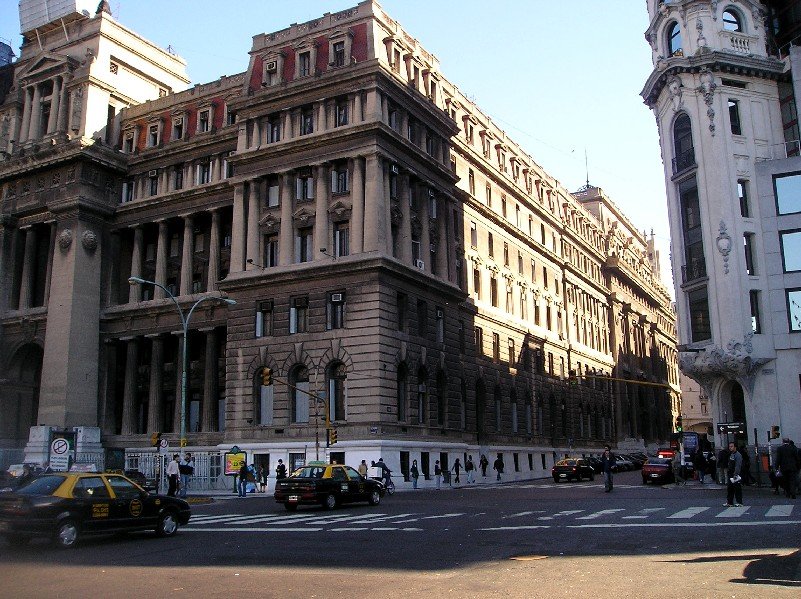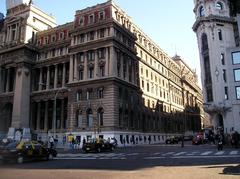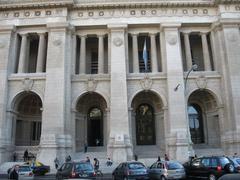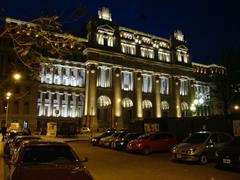
Palace of Justice Buenos Aires: Visiting Hours, Tickets, and Historical Significance
Date: 15/06/2025
Introduction
The Palace of Justice of the Argentine Nation (Palacio de Justicia de la Nación), commonly referred to as the Palacio de Tribunales, is a pivotal landmark in Buenos Aires. Epitomizing Argentina’s judicial heritage and neoclassical grandeur, this imposing building is both a functional seat of the Supreme Court and a cultural monument. Designed by French architect Norbert Maillart, the Palace stands as a testament to Argentina’s aspirations for justice, order, and national identity. Centrally located at Talcahuano 550, opposite Plaza Lavalle, it is surrounded by other significant institutions, making it an essential stop for those interested in the legal, architectural, and civic history of Argentina.
This comprehensive guide details the Palace’s visiting hours, ticketing, guided tours, architectural features, historical context, and practical visitor tips. Whether you are an architecture enthusiast, history buff, or curious traveler, the Palacio de Justicia offers a unique window into Argentina’s judicial and political evolution.
For the latest visitor information, including tour schedules and bookings, check the official Buenos Aires tourism website and the Supreme Court’s homepage (turismo.buenosaires.gob.ar, csjn.gov.ar).
Table of Contents
- Historical Overview
- Architectural Features and Symbolism
- Visiting Information
- Nearby Attractions and Urban Context
- Visitor Tips and FAQs
- Summary and Further Resources
Historical Overview
Architectural Vision and Construction
The idea for the Palace of Justice emerged during Argentina’s “Belle Époque,” a period marked by rapid modernization and European influence. The building’s design, awarded to Norbert Maillart in 1889, was delayed by the 1890 economic crisis. Construction resumed in 1905 under President Julio A. Roca, and the first inauguration coincided with the May Revolution Centenary in 1910. The Supreme Court moved in by 1912, but full completion was achieved only by 1942, with further adornments such as wrought-iron gates added in 1973 (turismo.buenosaires.gob.ar).
Restoration and Preservation
Major restoration projects between 2002 and 2007 focused on cleaning and repairing the main façades and interiors, with additional work continuing into the 2010s. These efforts have maintained the Palace’s original grandeur and ensured accessibility for future generations.
Judicial and Civic Role
The Palace serves as the nerve center for Argentina’s judiciary, housing the Supreme Court and several lower courts. Its central location near Plaza Lavalle underscores its importance in both legal and public life. The building has witnessed milestone moments, including the restoration of democracy and significant human rights rulings (EveryCulture).
Architectural Features and Symbolism
Exterior and Façade
Inspired by neoclassical and Beaux-Arts styles, the Palace’s exterior features imitation Paris stone, massive Corinthian columns, and classical motifs such as triangular pediments and arched windows. The monumental scale and symmetrical layout were intended to convey the authority and permanence of the state. Sculptures representing the tables of the law and statues of national heroes like José de San Martín (by Luis Perlotti) adorn the façade (Wikipedia).
Interior Highlights
The building’s vast interiors include:
- Entrance Hall: Dominated by Rogelio Yrurtia’s bronze sculpture “Justice,” symbolizing the building’s core purpose.
- Patio de Honor: A ceremonial courtyard used for official events and concerts.
- Supreme Court Audience Room: The main courtroom, with ornate woodwork, marble, and period furnishings.
- Art and Symbolism: Stained glass, intricate woodwork, and a replica of the “Bandera de los Andes” further infuse the space with cultural meaning (turismo.buenosaires.gob.ar).
Visiting Information
Hours, Tickets, and Tours
- Guided Tours: Available every Friday at 2:30 pm, conducted in Spanish. Tours last approximately 90 minutes and provide insight into the building’s architecture, history, and judicial function.
- Tickets: Admission is free, but advance booking is required via the Buenos Aires tourism portal.
- Identification: Valid photo ID (passport or national ID) is required for entry due to security protocols.
- Language: Tours are in Spanish; non-Spanish speakers can arrange private guides or translators.
Accessibility and Conduct
- Accessibility: The Palace offers ramps and elevators for visitors with mobility challenges, but some historic areas may remain difficult to access. Contact tour organizers for specific needs.
- Photography: Permitted in public areas during tours; restrictions may apply in courtrooms or during legal proceedings. Flash and tripods are generally not allowed.
- Dress Code: Smart casual attire is recommended out of respect for the institution.
- Restrooms: Facilities are available for tour participants.
Location and Directions
- Address: Talcahuano 550, facing Plaza Lavalle, Buenos Aires.
- Transport: The nearest Subte (metro) station is “Tribunales” on Line D. The area is also served by multiple bus routes and is within walking distance of major city landmarks (Lonely Planet).
Nearby Attractions and Urban Context
The Palace of Justice anchors one of Buenos Aires’ most vibrant districts. Within walking distance, visitors can explore:
- Plaza Lavalle: A historic park and gathering space.
- Teatro Colón: Renowned opera house.
- Templo Libertad and Museo Judío: Key sites reflecting Argentina’s Jewish heritage.
- Obelisco and Avenida Corrientes: Iconic city landmarks (thecollector.com).
The San Nicolás neighborhood features a mix of neoclassical, art nouveau, and art deco architecture, offering a rich urban tapestry to discover.
Visitor Tips and Frequently Asked Questions
Practical Tips
- Booking: Reserve guided tours at least a week in advance, especially during the October–April peak season.
- Arrival: Arrive 15 minutes early for security checks.
- Safety: The Tribunales area is safe during the day; exercise standard city precautions at night.
- Language Support: Arrange an English-speaking guide if needed (BA Walking Tours).
FAQs
Q: Can I visit the Palace on any day?
A: Public visits are limited to guided tours on Fridays at 2:30 pm.
Q: How do I book tickets?
A: Reserve tickets online in advance via the official tourism portal.
Q: Are tours available in English?
A: Regular tours are in Spanish, but private English-language tours can be arranged.
Q: Is the building fully accessible?
A: There is step-free access to main public areas, but some historic sections may be less accessible. Contact tour providers for details.
Q: Is photography allowed?
A: Yes, in most public areas during tours, but restrictions apply in courtrooms.
Summary and Further Resources
The Palace of Justice is more than an architectural marvel; it is a living testament to Argentina’s judicial and democratic journey. Guided tours offer exclusive access to its majestic halls and rich history, making it a must-visit for those seeking to understand Buenos Aires’ legal and cultural landscape.
Pair your visit with nearby attractions like Teatro Colón or Plaza Lavalle, and consult official resources for real-time updates. Enhance your experience by downloading the Audiala app for guided support and up-to-date information on Buenos Aires’ top historical sites (turismo.buenosaires.gob.ar).
Official Sources and Further Reading
- Palacio de Justicia Buenos Aires: Visiting Hours, Tickets, and Historical Guide (turismo.buenosaires.gob.ar)
- Visiting the Palace of Justice Argentina: History, Tickets, and Travel Tips (EveryCulture)
- Palace of Justice Buenos Aires Visiting Hours, Tickets, and Visitor Guide (Wikipedia)
- Detectives’ Guide to Buenos Aires Architecture (theworld.org)
- Buenos Aires Historical Sites Guide (thecollector.com)
- Official Supreme Court of Argentina Website (csjn.gov.ar)
































































































































































